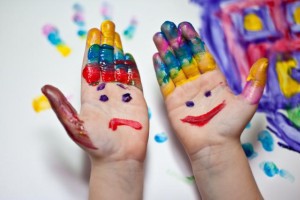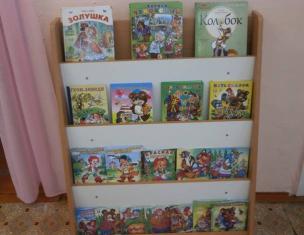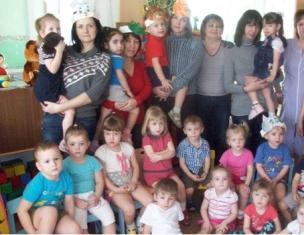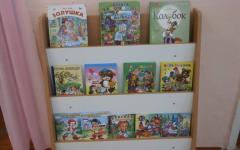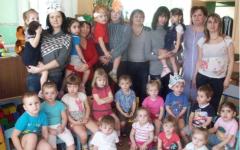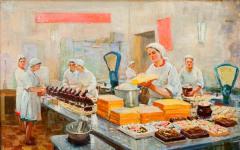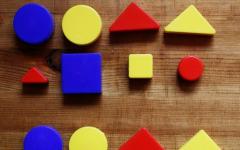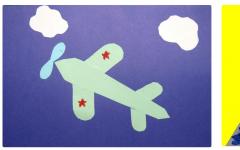«Kostanay қ Аласа әKіmdіigіnің қostanay қalatsi әkіmdіigіnі білім Бліміміңңңң
№ 44 Bөbeji - Bakshasa "MKKK
GKP "Nursery - Garden No. 44 Akimat Kostanaya
department of Education Kostanaya "
____________________________________________________
Collection of practical materials
"Didactic game card
on unconventional drawing "
educator
Pelovina Veronika Vyacheslavovna
Kostanay
2016
A little about non-traditional drawing ...
We all well know that drawing one of the biggest pleasures for the child, its inner world reveals in it. Drawing, the child reflects not only what sees around, but also shows his own imagination. And adults should not forget that positive emotions make up the basis of mental health and the emotional well-being of children. And since the drawing is a source of good kid mood, we, teachers need to be maintained and developing the child's interest in visual creativity.
An important component of non-traditional drawing activities is interaction with parents. In order to interest parents with their work, it is worth organizing:
thematic parent meetings ("Drawing - Play" - Objective: Show parents The importance of joint creative games in the family for the creative development of the child; familiarize yourself with the traditions and forms of game leisure activities in families; learn games for the development of creative imagination);
consultation("Using non-traditional methods of drawing in the development of children's creativity "," develop children's creativity "," Development of communication of children and parents in the process of drawing classes ");
exhibitions ("Magic palms");
joint creativityand etc.
Together with parents of pupils to enrich the corner of artistic creativity in the group of card files of non-traditional drawing methods and didactic games,postcards, photo albums, sketches and samples of work, paints of various compositions, unconventional tools for visual activities (printing and stamps, stencils, crayons wax, candles, foam rubber, cakes, cotton wands, cocktail tubes), dull material, selection of fiction and fiction and etc.
This will allow the guys to show great independence, initiative, fantasy; increase emotional well-being; The guys will learn to combine non-traditional fine technologies to create an unfinished image; Will be able to give a motivated assessment results of their activities.
In the process of creativity, the child develops intellectually and emotionally, determines its attitude to life and its place in it. One way to develop creativity of children is the use of non-traditional drawing techniques. Drawing with unusual materials and original techniques allows children to feel unforgettable positive emotions. Children find out for themselves something new and unique, it is created that which has not existed before. Children reveal for themselves the opportunity to use well-acquired items as artistic materials, surprise their unpredictability. The introduction of non-traditional techniques is developing the work of children, instills love for visual arts.
Working in non-traditional visual techniques contributes to the removal of tension, improving the emotional state of children by preserving sustainable interest in various types of activities, while developing creative abilities, contributing to improving self-esteem, activating the cognitive activity of pupils; It makes it possible to make the process of admiration for children to the world of art brighter, fascinating, meaningful.
List of references:
1. G. N. Davydova "Non-traditional drawing techniques in Dow. Part 1, 2 ". - M.:" Publishing Scripture 2003 ", 2008.
2. G. P. Evstafieva "Learn to draw", Yaroslavl, Academy of Development, 2005.
3. R. G. Kazakov "Cooking classes with preschoolers: non-traditional techniques, planning, abstract classes." - M.: TC Sphere, 2009.
4. Kazakova R. G. "Drawing with children of preschool age", m, sphere, 2007
5. D. N. Koldde "Drawing with children is 4-5 years old." - M.: Mosaic - Synthesis, 2008
6. Komarova T.S. "Fine activity in kindergarten", M., 1982
7. Komarova T. S. Philips O.Yu. "Aesthetic Education Wednesday in Dow", Pedagogical Society of Russia, M., 2005
Kosheleva A. D. "Emotional Development of a Preschooler", M.: Enlightenment, 1985
A. V. Nikitina "Non-traditional drawing techniques in Dow. Manual for educators and parents. " - St. Petersburg: Karo, 2007.
G. A. Uruntaeva "Diagnosis of psychological peculiarities of a preschooler",
M.: Publishing Center "Academy", 1996
Fateeva A. A. "Draw without brushes", Yaroslavl, ed. Academy of Development, 2004
Applications
Card file of non-traditional drawing methods
MonotypiaWhite paper sheet should be bent and dispersed in half. Put on the line of fold 2-3 multicolored spots of gouache. Fold the sheet in half and spend your finger from the center to the edges. Open a sheet and get a flower! After drying, the felt-tip pen remains to be drawing small details.
N. 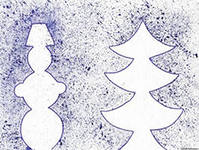 absorgThe child picks up the paint on the brush and hits the brush about the cardboard, which holds over the paper. Paint splashes on paper.
absorgThe child picks up the paint on the brush and hits the brush about the cardboard, which holds over the paper. Paint splashes on paper.
GRITAZH White paper sheet coloring with watercolor paints. Then you need to cover the candle. Then paintblack gouache (if the paint is bad to fall, you can add soap foam into it). Then, after the sheet of paper dries with the knob, you can scat out the drawing.
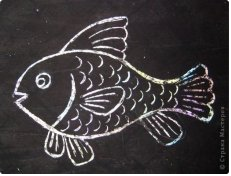
Cleaxography Normal
The child jumps the gouache with a plastic spoon and pours on paper. As a result, stains are obtained in an arbitrary order. Then the leaf is covered with another sheet and pressed (you can bend a sheet in half, one half the mascara drop, and the other cover it.) Next, the top sheet is removed, the image is considered: it is determined to what it looks like. The missing details are described.
Cleaxography with tube
The child scoffs with a plastic paint with a plastic spoon, pours it onto a sheet, makes a small stain (droplet). Then the stain blows from the tube so that its end does not touch the spots or paper. If necessary, the procedure is repeated. The missing details are described.
Cleaxography with thread
The child lowers the thread in the paint, pressing it. Then the image is laying on a sheet of paper, leaving one end free. After that, the top of the other sheet opens, presses, holding the hand, and pulls the thread for the tip. The missing details are described.
INolshehta string
Bend and break the white cardboard sheet. Pulse a thick woolen thread in the paint and place it between the two halves of the sheet. Slightly pressing on the sheet, drive a thread. Dorisite details.
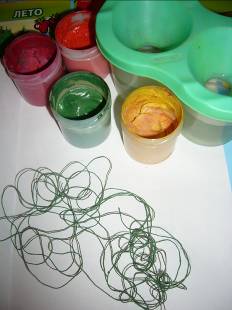
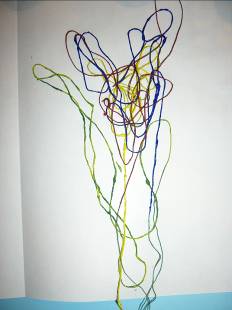
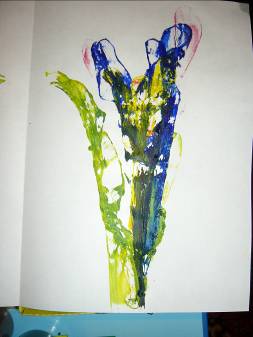
Drawing potatoes, finger, bulb
Pebbles. Cut potatoes in half. Spend the fork tooth several times by creating a relief on the cut. Plug potatoes in paint and make a print.
Fish. Type the body with a thumb with a thumb, and the tip of the index finger is the tail. Feltaster Draw eyes and mouth.
Bubbles. Print the plastic straw.
PLANTS. Cut the bulb and make a print.
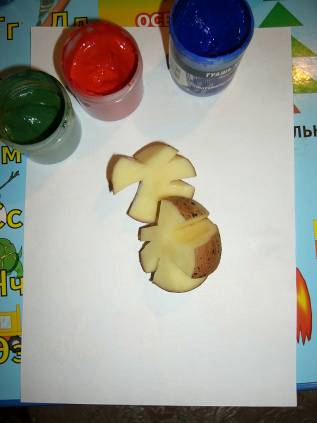
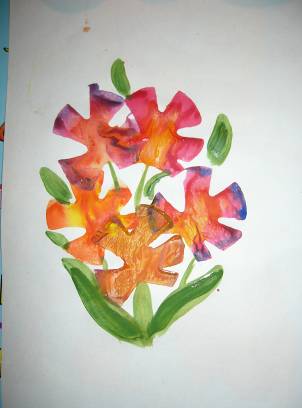
T. 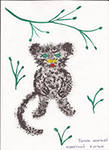 hay rigid semi-dry brush
hay rigid semi-dry brush
The child lowers a brush in the gouache and hits her on paper, holding a brush vertically. When working, the brush does not fall into the water. Thus, the entire sheet, contour or template is filled. It turns out imitation of a fluffy or barbed surface.
Drawing soap bubbles
On the glass it is necessary to apply with watercolor paints with the addition of soap bubbles. A sheet is superimposed on the glass with a low pattern. Then swipe your finger from the center to the edges. Remove the glass. After drying, the felt-tip pen is dorisite small details.
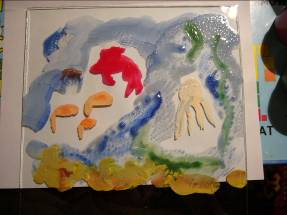
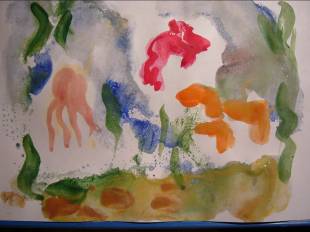
R 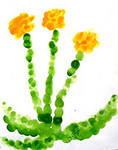 holding fingers
holding fingers
The child lowers his finger into the gouache and puts points, specks on paper. Each finger is gaining paint different colors. After working, the fingers are wiped with a napkin, then the gouache is easily flushed.
Collage
In the house there will always be unnecessary postcards, photos, colored paper cuts from magazines that can be connected to a large collage. When with the help of glue and scissors you will create your canvas, can squeeze the background or parts of the paint pattern. It should turn out something very interesting.
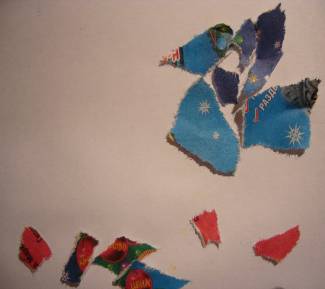
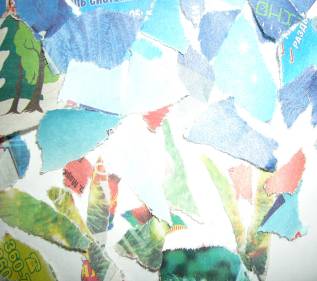
Drawing palm
R 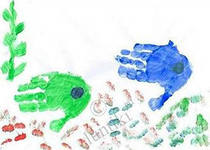 ewenok lowers his palm in the gouache (all brush) or paints it with a brush and makes a print on paper. Drawn and right and left hands painted with different colors. After working, the hands wipe the napkin, then the gouache is easily flushed.
ewenok lowers his palm in the gouache (all brush) or paints it with a brush and makes a print on paper. Drawn and right and left hands painted with different colors. After working, the hands wipe the napkin, then the gouache is easily flushed.
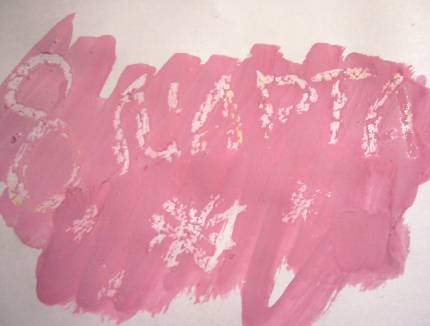 Magic candle
Magic candle
Wax candle draw on dense paper Christmas tree or house. Then, with the help of foam rubber, start to apply paint to the entire surface of the paper. Since the house drawn candle will be fat, the paint does not fall on it, and the drawing will suddenly manifest. The same effect can be obtained, first drawing by the stationery glue.
ABOUT  tPCs of leaves
tPCs of leaves
The child covers a leaf of wood with paints of different colors, then applies it to the paper painted side to receive a print. Every time the new sheet is taken. Packers in leaves can be drawn with a brush.
Watercolor with salt
If it is not yet a dried watercolor drawing to sprinkle with salt, then the salt will stick to the paint and when drying will create the effect of graininess.
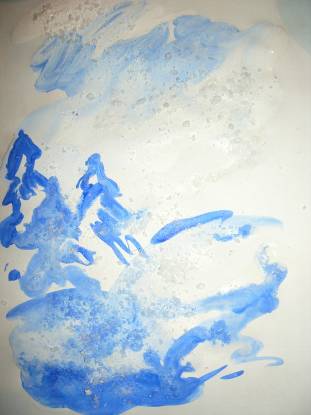
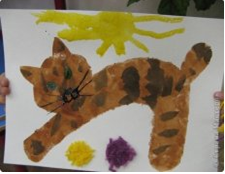 Patrolone drawing
Patrolone drawing
The child foys a piece of foam rubber in the paint and draws a mixing method. It is very good to draw in such a way of fluffy animals, snow, snowman, and it is possible to paint the background very easily. It is also very good to use stencils with such drawing.
Drawing with fingers on the cereal
On the tray croupe (manka) is scattered. Children with fingers create familiar simple images.
Drawing with cotton chopsticks
Cotton wands are very simple. I lower the wand into the water, then in the paint and put on the point of the point. What to draw? Yes, anything! Sky and sunshine, house in the village, river, cars, dolls. The main thing in this business is desire!

Crushing with mint paper
The child's moment in the hands of paper until it becomes soft. Then rolls the ball from her. Its dimensions can be different. After that, the child presses a crumpled paper to a stamped pillow with paint and puts off on paper.
Consultations for parents
"Develop the creativity of children"
The development of the creative potential of the individual should be carried out from early childhood, when a child under the guidance of adults begins to master various activities, including artistic. Great opportunities in the development of creativity concludes visual activities and, above all, drawing. Drawing is an important means of aesthetic education: it allows children to express their idea of \u200b\u200bthe environment, develops fantasy, imagination, makes it possible to consolidate knowledge about color, form. In the process of drawing, the child is performed by observation, aesthetic perception, aesthetic emotions, artistic taste, creative abilities, the ability to create a beautiful means available to the means available tools. Classes drawing develop the ability to see beautiful in the surrounding life in the works of art. Own artistic activities helps children gradually approach understanding the works of painting, graphics, sculptures, decorative and applied arts.
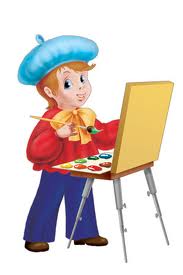 The image in the figures is created using a variety of materials. Artists in their work use various materials: a variety of small paints, coal, sangu, pastel and much more. And in children's creativity it is also necessary to include different colors (gouache, watercolor), mascara, crayons, teach children to use these visual materials in the ratio with their means of expressiveness. Work experience shows: drawing by unusual materials and original techniques allows children to feel not forgotten positive emotions. Emotions, as you know, is the process, and the result of practical activity, primarily artistic creativity. By emotions, it is possible to judge that at the moment I am glad, interests, it turns into a despondency, carefully the child, which characterizes its essence, character, personality.
The image in the figures is created using a variety of materials. Artists in their work use various materials: a variety of small paints, coal, sangu, pastel and much more. And in children's creativity it is also necessary to include different colors (gouache, watercolor), mascara, crayons, teach children to use these visual materials in the ratio with their means of expressiveness. Work experience shows: drawing by unusual materials and original techniques allows children to feel not forgotten positive emotions. Emotions, as you know, is the process, and the result of practical activity, primarily artistic creativity. By emotions, it is possible to judge that at the moment I am glad, interests, it turns into a despondency, carefully the child, which characterizes its essence, character, personality.
Preschoolers for their nature are able to sympathize with the literary hero, playing emotional various states in a complex role-playing game, but to understand that there is beauty, and learn how to express yourself in the visual activity - a gift that you can only dream about, but this can be taught. We are adults, you need to develop a sense of beauty in the child. It is from us that the rich or poor - will be his spiritual life. It should be remembered: if the perception of the wonderful will not be supported by the participation of the child in the creation of beauty, then, according to the child, "infantile enthusiasm" is formed. To instill love for visual arts, cause interest in drawing preschool age, it is necessary to use unconventional image methods. Such unconventional drawing gives children a lot of positive emotions, reveals the possibility of using well-known objects as artistic materials, surprises its unpredictability.
Unusual methods of drawing so fond of children, which, figuratively speaking, the present flame of creativity flames in the group, which is completed by the exhibition of children's drawings.
What non-traditional drawing methods can be used at home? Cleaxography, drawing salt, drawing with fingers, soap bubbles, splashing etc.
Do you not interest you to find out what happens if you draw with a rag or crumpled paper? You can draw as you like and anything! Lokia on the floor, under the table, on the table. On a piece of wood, on the newspaper. A variety of materials puts new tasks and makes something invent something all the time. And from the Karakul and Mazni eventually a recognizable object is evaporated. Nothing the unmandant joy of satisfaction from the fact that "I did it - all this is my!".
Having learned to express your feelings on paper, the child begins to better understand the feelings of others, learns to overcome timidity, fear of drawing, before anything happens. He is sure that it will turn out, and it will turn out beautifully. Mastering various materials, ways to work with them, an understanding of their expressiveness allows children to more effectively use them when reflected in the drawings of their impressions from the surrounding life.
The variety of visual materials makes the visual activity more attractive, interesting, and as many materials are mastered by various materials in children, its manner is formed. One of the favorite children of non-traditional drawing methods is drawing salt. It possesses not only interesting decorative possibilities, but also very convenient in circulation. They love to draw and ... soap bubbles. You can draw in the way of blowing. But you can draw a toothbrush, and cotton, and a finger, palm, swab, mint paper, driving a paint (drop) pipe on a sheet of paper, print with different objects, create composition with a candle, lipstick, feet. Dare, fantasize! And the joy will come to you - the joy of creativity, surprise and unity with your children.
Drawing art has a variety of techniques and they must be used in working with children. The use of various materials enriches children with knowledge of ways to work with them, their pictorial opportunities, will make pictures of children more interesting, increase the aesthetic side of the picture.
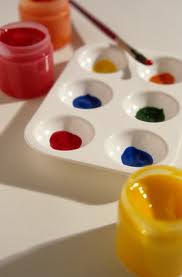
"The use of non-traditional drawing techniques
in the development of the creativity of children "
Undoubtedly, pictorial activities of children of preschool age consider the most interesting. Just having painted yourself with flomuses or staining watercolor, the child understands - there is happiness in life. How to teach a child to draw if you do not know how? Do not hurry to get upset. There are many techniques with which you can create original work, not even having any artistic skills. And you, and your child will receive from such classes not only pleasure.
Practice use
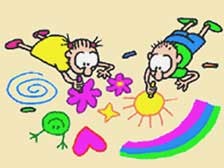 We are adults sometimes we do not share this happiness, and even indignant to the depths of the soul, looking at the arts of the kid on the walls in the apartment.But drawing is of great importance in the formation of the identity of the child.Therefore, before scolding the baby, try to direct his work in the right direction.From drawing, the kid receives only the benefit. Especially important is the connection of drawing withthinking baby. At the same time, visual, motor, muscularly tangible analyzers are included in the work. In addition, drawing is developingmemory, attention, petty motor skills, teaches a child to think and analyze, compose and compare, compose and imagine. For the mental development of children, the gradual expansion of knowledge stock has great importance. It affectsformation of the vocabulary and connected speech in the child.Agree, a variety of forms of objects of the surrounding world, various quantities, varieties of colors of colors, spatial designations only contribute to the enrichment of the kid's dictionary.
We are adults sometimes we do not share this happiness, and even indignant to the depths of the soul, looking at the arts of the kid on the walls in the apartment.But drawing is of great importance in the formation of the identity of the child.Therefore, before scolding the baby, try to direct his work in the right direction.From drawing, the kid receives only the benefit. Especially important is the connection of drawing withthinking baby. At the same time, visual, motor, muscularly tangible analyzers are included in the work. In addition, drawing is developingmemory, attention, petty motor skills, teaches a child to think and analyze, compose and compare, compose and imagine. For the mental development of children, the gradual expansion of knowledge stock has great importance. It affectsformation of the vocabulary and connected speech in the child.Agree, a variety of forms of objects of the surrounding world, various quantities, varieties of colors of colors, spatial designations only contribute to the enrichment of the kid's dictionary.
In the process of visual activity, the mental and physical activity of the child is combined. To create a picture you need to make efforts, work out, weighing certain skills. At first, children are interested in the movement of a pencil or brush, to the trails left on paper, only gradually makes a motivation for creativity - the desire to get the result, create a specific image. Remember, each child is a separate world with its own behavior rules, their feelings. And the richer, the most diverse the vitality of the child, the brighter, an extraordinary imagination, the most likely that the intuitive thrust for art will be meaningful with time. "The origins of the abilities and dating children - on the tips of their fingers.From fingers, figuratively speaking, the finest threads are going - the streams that feed the source of creative thoughts. In other words, the more skill in a children's hand, the smarter the child, "said V.A.Sushellinsky.
Imagination and fantasy
- This is the most important side of the child's life. And the imagination develops especially intensively between 5 to 15 years. Together with a decrease in the ability to fantasize children, the personality is imposed, the possibilities of creative thinking are reduced, it goes out of interest in art, creative activity. In order to develop a creative imagination in children, a special organization of visual activities is needed.
How to teach a child to draw?
If you have already thought about the way to teach a child to draw Try to observeforthis is the followingprinciples:
Never ask the baby to draw you something specific on request, you can only offer several options to choose from, but do not insist that the child must have drawn something from the proposed one; Let him better draw what he conceived himself. Never criticize worklittle child; Yes, he is still imperfect, he draws as it can, but draws with a soul; If you constantly criticize him, he may even give up this lesson. Never under any pretext do not give anything and do not improve in the works of the child, it is also offended by him, emphasizes his inferiority, the inability to draw well (often parents do it, to then demonstrate the work of the child to relatives and acquaintances as its achievements).
Never teach a child to draw any specific image, as it kills him fantasy, imposes stamps to certain images (your vision); Better to teach the child to techniques to work with materials, drawing different forms, and from these skills, he himself will benefit and will draw unusual, nor on whose not similar images of a particular subject or creature.
Encourage non-standard solutions of images or techniques; Let the kid understand that the main thing is to his fantasy.
Consider and discuss his previous work so that he does not forget that he is already able to draw that he has already happened very well; Try to post the child's work on the wall. Consider the works of other children so that he wanted to draw as well. Consider the reproductions of paintings by different artists, go to art galleries. How do you like to work with the materials you can teach your child?
Methods and asE.We are non-traditional drawing.
Cleaxography. It is to teach children to make blots (black and multicolored). Then a 3-year-old child can look at them and see images, objects or individual details. "What is like yours or my blots?", "Who or what does she remind you?" - These questions are very useful, because Develop thinking and imagination. After that, without hosting a child, but showing, we recommend proceeding to the next stage - Circuit or Dorivovka Kleks. As a result, a whole plot can be obtained.
Drawing together on a long paper strip. By the way, the paper format is useful to change (i.e., not only the standard). In this case, the long strip will help draw together, without interfering with each other. You can draw insulated objects or plots, i.e. Work nearby. And even in this case, the child is warmer from the elbow mom or dad. And then it is advisable to go to collective drawing. Adults and the child negotiate who will draw that one plot turns out.
Drawing with a secret in three pairs of hands. When your child is 4 years old, we strongly advise you to resort to this method. It is as follows. A rectangular sheet of paper is taken, 3 pencils. Adults and child are distributed: who will draw the first one who is the second who is the third one. The first begins to draw, and then closes his drawing, reducing the sheet from above and leaving a little bit, some part, to continue (neck, for example). The second, without seeing nothing but the neck, continues, naturally, the body, leaving the visible only part of the legs. The third finishes. Then the entire sheet opens - and it is almost always funny: from the inconsistency of proportions, color hammes.
Drawing itself
or drawing from the nature of your favorite toys.
Drawing from nature develops observation, the skill is no longer done, but to depict according to the rules, i.e. Draw so that it looks like the original and proportions, and forms, and color. Offer at the beginning to draw yourself, looking into the mirror. And certainly, after looking at the mirror. And even better, show how you, adults, will draw yourself, by sure many times looking in the mirror. Next, let the child himself choose the subject, it can be a favorite doll, a teddy bear or a car. It is important to learn to observe a long time, comparing part of the subject.
"I draw mom" ... It would be nice to continue drawing from nature or memory drawing (family members, relatives and friends can become objects for such an image). As an auxiliary material there may be photographs or conversations about the characteristic features of the appearance of missing relatives. Pictures are taken and considered. A conversation is held: "What grandma Valya? What is her hair? Hairstyle? Favorite dress? Smile?" And the process of creation begins. After a while, you can offer to draw a memory of the girlfriends. When there are enough drawings withthe image of relatives and friends, we advise you to organize the mini-exhibition "My relatives and loved ones", where the first portraits of the preschooler are evaluated.
Didactic Games and Exercises
on unconventional drawing
"Amazing palm"
Purpose: Development of imagination, figurative thinking, visual skills, artistic taste.
Equipment: samples of drawings made on the basis of the standard (image of the palm opened); sheet of paper, simple pencil, eraser, sets of color pencils, wax chalks, paints and brushes (for each child).
Game traffic: The educator invites children to circle his palm with open fingers. After the preparatory work is completed, he says:"Guys, you got similar drawings; Let's try to make them different. Draw some details and turn the usual image of the palm into an unusual drawing. " The fantasy of the child will turn these contours into funny drawings: in octopus, hedgehog, bird with a large beak, clown, fish, sun, etc. Let the kid color these drawings.
Note: In case of difficulty, the adult shows samples of the task, but warns children that they should not copy them.
For example:
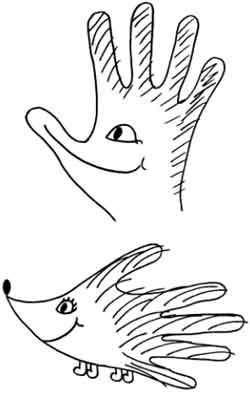
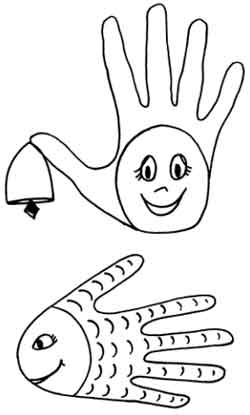
"RAINBOW"
Purpose of the game: Teach children to draw a rainbow, correctly call her colors, help remember their location, develop speech and vocabulary.
Equipment: rainbow drawing sample on A2 format sheet, landscape sheets for children, tassels, gouache or watercolor paints of different colors, jars with clean water, rags, palette for mixing paints (if necessary).
Game traffic: when everything is prepared on the tables of children, the teacher says that today the game will be devoted to the Rainbow, and asked if anyone saw a rainbow on the street, at what time of year it was - in winter or in summer, what the weather was at this time - sunny or only What passed heavy rain.
After the children respond to the questions set, the educator shows the entire sample of the rainbow drawing and asks the guys to call the colors that they saw. Then the chorus is then learned by a phrase that helps remember the location of flowers in the rainbow: each (red) hunter (orange) wants (yellow) to know (green) where (blue) sits (blue) pheasant (purple).
The next stage you can ask the guys to draw a rainbow yourself, using watercolor paints for this. If the children in the group learned the material well and know how to produce different colors from red, blue and yellow, they may well draw a rainbow using only three main colors for this.
If the kids are not yet ready for this, the educator asks them to draw this picture using already ready-made paints of purple, orange and green colors.
"BLACK AND WHITE"
Purpose of the game: Develop attentiveness, dexterity, speed, the ability to act quickly depending on the situation.
Equipment: A cardboard disk with a diameter of 30-40 cm, one side of which is painted in white, the other in black.
Game traffic: The educator divides all players for 2 teams: "black" and "white", which are built along the battered lines against each other. One team should catch another, but it can be done only after the resulting signal and only on a playing field, which is limited to the drawn lines. The teacher throws the disk, and everyone looks like a color up he fell. If this is black, then the "black" team begins to catch the team "White", which in turn try to slip over the opposite line, which is now considered to be their house. All caught participants overlook. The team wins the team in which the larger number of players remains.
To secure the names of flowers, you can paint into other colors (for example, on one side in blue, on the other - in green). You can use other combinations that help the guys in the game form remember the necessary shades.
"Multicolored domino"
Purpose of the game: Teach children Rules for children's dominoes, show the importance of selecting the desired color, continue learning the correct name of the colors.
Equipment: Children's domino of 28 pieces, in which, instead of pictures, the squares are painted in different colors (which should be 7 species).
Game traffic: The tutor dials the team of players in which there must be no more than 4 people, and distributes domino. Each participant gets 7 pieces. After that, one of the players who got a red-red card laying it on the table. The next participant puts the domino, in which one of the squares is painted in red. Next, you must lay out the card so that the colors coincide. If the child does not have the necessary color, then he misses the move. The person whom the Domino card will be completed before the rest.
If only 2 or 3 people participate in the game, then 14 or 7 cards inverted with flowers should remain on the table. They will serve as a spare for those guys who have no desired color during the game.
To better consolidate the name of the colors, it is desirable to ask for children to call them when they lay out the necessary card on the table.
"Merry monkeys"
Purpose of the game: To form skills for distinguishing and correctly called colors, develop speed, dexterity, artistry, the ability to act independently in the current situation.
Equipment: Monkey masks for each participant, 2 goals, 2 hoops, 2 gymnastic sticks.
Game traffic: The tutor dials the team of players in which there should be 8-10 people, and asks the participants to wear monkey masks. For the game, another child is required to play the role of water. The conditions of the game are that the leading turns away from monkeys, calls color, and asks to perform a certain task. If the participant of the game easily coped with the task received, then he remains in the team, but if he did not cope, it drops out. The winner becomes the monkey that was able to fulfill all the tasks. Jobs for participants may sound as follows: 1) Guess, in what hand I hid the candy; 2) You must sit in place 10 times; 3) answer the question how shouts the cock, and demonstrate it 3 times; 4) Tell me the funny story that happened to you in life; 5) There are 2 circles around the table; 6) Others (depending on the age of participants
"Magic Circle" (Color Circle ")
Purpose of the game: Secure children's knowledge about the main and composite colors, about warm and cold colors. Systematize children's knowledge about various types of painting, artists working in these genres. Rail interest in art. Intensify the speech of children.
Equipment: Circle cut from plywood, 50 cm diameter, divided into 7 sectors painted in basic and composite colors. In the center of the circle there is an arrow, which is rotated by hand. Cards with the image of landscapes, still lifes, portraits for each player (10x10), red circle, 6 cm diameter, green square (6x6) for each player, prize chips.
Game traffic: The teacher recalls children that in the kingdom of the king palettes live different paints: the main - red, blue and yellow and composite - which are obtained by mixing 2 main colors. This is orange, purple and brown paint. The tutor offers children to play with the magic circle. The educator explains the rules: after he starts to rotate the arrow, the children carefully watch the arrow will stop on. They must determine what color is: basic or composite and quickly raise the geometric shape: a circle for the main color, a triangle for composite. The chip receives a child who quickly and correctly fulfill the task. An extra chip receives a child who will be the first to tell, from which two main colors compiled color.
2 Game Option:
The tutor lays out on the color circle of the card with the image of the landscape, still life or portrait. Among the cards there are images of paintings with whom they have already met in class: Levitan "Golden Autumn", Shishkin, Serov, Vrubel, Grabar, and others.
The tutor rotates the arrow. After stopping the arrows, children are invited to name the genre of painting. Correctly called the chip. Additional chips can get children who can call the author's paintings, its name. The educator can offer children in turn to rotate the arrow.
"Circus lights lights"
Purpose of the game:
Learn to create a holistic circus picture on the podmuelka, solve problems on the spatial leaf development. Secure the knowledge of children about circus artists, attributes used on ideas. Check out the knowledge of artist costumes: acrobats, jugglers, clowns, animal tamers.
Activation of the dictionary of children: Arena, spotlights, trainers, juggles, etc.
Game traffic:
The teacher invites children to consider the approach of the circus arena, attributes and inventory that artists are used for performances. Then we consider the figures of circus artists, their costumes, circus animal figures. The teacher offers children on the podmuelka to lay out a circular number and tell about him. It is necessary to assist children when compiling the composition on the podmuelka.
"Folk costume"
Purpose of the game:
Acquire children to past national culture. Fasten knowledge about the peculiarities of a folk costume: hats, elements of clothes. Develop common educational abilities:
- the ability to describe the objects of clothing, suggests;
- compare your image with people who lived earlier;
- classify the items of the costume depending on the position of people in society (simple peasants, clergy, know, warriors).
Develop aesthetic taste, bring up a sense of pride in the Russian people.
Activation of the dictionary of children: "Wreath", "Sharovari", "Scroll", etc.
Game traffic:
The game is designed for the fact that children are familiar with verses T.G.Shevchenko, Ukrainian folk tales. Preliminary work was carried out on acquaintance with the work of artists-illustrators, with pictures of the poet and the artist Shevchenko.
The teacher reads an excerpt from fairy tales and suggests to wear a hero in the costume, explain the choice of costume, the name of the details of the costume.
Game option: Children are invited to compare costumes of the heroes of folk fairy tales and heroes of foreign fairy tales.
"UNDERWATER WORLD"
Purpose of the game: Secure the knowledge of children about the inhabitants of the underwater world. Teach children carefully consider the form, painting, features of the structure of underwater inhabitants. Learning to create a multifaceted composition on the podmuelka. Develop a shallow motor. Intensify the dictionary of children.
Game traffic: Together with the teacher, children remember who lives in the seas and oceans, clarify the structure of the body and painting. Then, at the submarine, children create a picture of the underwater world, placing items multifaceted. The chip receives the child who has turned out a more interesting picture, one who used many details to create a picture of the underwater world.
"THEATRE"
Purpose of the game: To acquaint children with the type of art - theater. Explain the conventions of this genre: suit, scenery, scene. Teach children to pick up the scenery, costumes for heroes. Learning to create a plot composition on podmuelka, create a theatrical action. Develop imagination, fantasy, acting skills. Exercise in the compilation of a connected story. Intensify the dictionary of children.
Preliminary work: The teacher tells children about the form of art - theater and its features: in the theater there is a scene on which theatrical action takes place. The stage is the actors who can perform a wide variety of roles: depict animals and people, fabulous heroes. For this, theatrical artists create suits. For the same performance, different scenery and suits can be created. All the actors will definitely teach their roles and try to convey the images of their heroes.
Game traffic:
The teacher shows the scene to the children and proposes to draw a fairy tale at the request of children. Children remember the heroes of the fairy tale, select the appropriate scenery, lay the theater action on the submarine and talk about it.
Option game:
The teacher examines theatrical costumes, invites children to characterize these heroes, pick up the necessary scenery, put theatrical action on the submarine and tell about it.
"Come to the landscape"
Purpose of the game:
Exercise children in compiling a composition with multiple content, allocation of the main size. Exercise children in the compilation of the composition combined with a single content. Fasten the knowledge of children about seasonal changes in nature. Declaring the knowledge of children about the landscape as painting, consolidating knowledge about artists working in this genre. Develop the observation of children, creative fantasy.
Intensification of the dictionary: "Landscape", "Painting", "Seasons".
Game Material: "Submalevki" of different times of the year, carved silhouettes of trees (corresponding to different times of the year), wooden houses, churches, chips.
Game traffic:
The educator decides in front of the children of "submarine" 4 times of the year and trays with carved trees and houses silhouettes. Children are invited to listen to the poem about the time of the year, to determine when this happens and come up with a picture of nature that corresponds to this time of the year.
Autumn on the edge of paint bred, in the foliage, quietly passed the brush.
Yezhechnik yells and kleples. In Purple Osinka, only the oak green.
Autumn comforts - do not spare summer! Look - grove gold dressed!
The signal to the beginning of the work is the inclusion of music from the Album P.I. Tchaikovsky "Seasons". Children make up the picture while the music fragment sounds. The teacher then examines the resulting patterns, together with children, determines the correctness of the composed composition. The chip receives that child who correctly decided the task of the composition of the sheet, passed the perspective, correctly chosen items in size. Additional chips can get a child who will tell about artists working in this genre, will be able to call their paintings.
The tutor reads the poems about the other time of the year, includes music, and children make up a new landscape.
« Pick images to the toy »
Purpose of the game: Teach children with visual analysis of the silhouette and the form of the real subject. Exercise vision in shape selection in a plane image and volumetric subject.
Game traffic: Children are distributed cards with silhouette images. On the tray lie volumetric items: toys, building material. The teacher proposes to put under each silhouette the subject of the corresponding form. Wins one who will soon fill all the cells.
Game options can be diverse. For example, the picture shows real objects, children select silhouette images carved from cardboard and impose on real images.
The formation of comparison methods, analysis of objects and their images is an effective method for enriching subject representations. This is promoted by the game type "Tax Issues to its image", "Make an object from parts", "Find the same subject", "Find the same half an object, images."
At the same time, it is important to take into account individual distinctive features. With low visual sharpness and the absence of images perception skills, it is better to start working on the compaction of the subject with its real, color image, and then you can proceed to the compaction of the item with the silhouette image.
"Who more and quickly draws a circle"
Purpose of the game: Exercising children using drawing on sterns in the image of circles of different magnitude, teach children to draw straight lines to the circles, depict the apple and cherry berries.
Material: stencils with slots of different types of circles, markers, sheets of paper.
Game traffic: The teacher proposes to consider stencils, highlight large and small circles, shows how to put the stencil how to circle. You can offer children to paint the circles, without removing the stencil, the painting will have a circular movement, as they paint the threads. You can show children transformation of circles into the ball by dividing the circle with two lines: one is drawn - left - right, and the other is drawn - right - left.
"What! What! What! "
Children get into the circle, transmit any natural object from hand to hand. Having become acquainted with him, the child must express his feelings in the Word. Moving in a circle, the natural object gradually reveals its new faces before us. For example, acorn - oval, smooth, solid, etc.
"What looks like"
Children pass the natural object in a circle, comparing it with other familiar objects. For example, spikelets - on wood, ponyths of birds, bakeup, pigtail, tail, etc.
"Collect the pattern"
The educator offers children individually lay out on paper circles or stripes pattern from flat natural shapes - pumpkin seeds, watermelon, melons, etc. It is used to receive alternations of contrasting in the form and color of natural materials.
"Treatment"
The educator offers children using various natural materials, put on a sheet of paper any, familiar image, and then from the same details to create a completely different image.
"Pebbles on the shore"
purpose games: Teach children to create new samples based on the perception of schematic images.
Material: A big picture, which depicts a seashore, a few pebbles (5 - 7) of different shapes (each stone has similarities with some object, animal or man).
Game traffic: An adult shows a picture of children and says: "On this shore, a wizard was held and all in its path turned into pebbles. You must guess what was on the shore and come up with a story about every pebble. What it is? How did he get on the shore? Etc."
"Cheerful Gnome"
Purpose of the game: Teach children to create images based on the perception of a schematic image of the subject.
Material: The picture on which is depicted by a gnome with a bag in hands and a few cut bags of different shapes cut from paper, which can be applied to the drawing and change in the hands of the gnome.
Game traffic: The adult shows the picture to children and says that the gnome came to visit children; He brought gifts, but that children should guess themselves. Come up with the story about one of the gifts and about the child who received it.
"WHAT DOES IT LOOK LIKE"
Purpose of the game: Teach children in the imagination to create images of items based on their schematic image.
Material: set of 10 cards; On each card, one figure is drawn, which can be perceived as a detail or contour image of a separate item.
Game traffic: Adult shows a picture from a set and asks what it looks like. It is important to support the initiative of children, emphasize that each child should give its original answer.
"Wonderful forest"
Purpose of the game: Teach children to create a situation on the basis of their schematic image in the imagination.
Material: The same sheets of paper on which several trees are drawn and in different places are unknown, unformed images. Sets of colored pencils.
Game traffic: An adult distributes paper sheets and suggests to draw a forest, full wonders, and then tell me a story about him.
"Perevils"
Purpose of the game: Teach children to create in the imagination of objects of objects based on the perception of schematic images of individual details of these items.
Material: Pencils, sets of 8 - 16 cards. Each image is located in such a way that there is a free space for trying the picture.
Game traffic: Adult invites children to paint into the figure, anything, but so that it turned out the picture. Then you need to take another card with the same figure, put it upside down or sideways and turn the figure to another picture. When children fulfill the task - take cards with a different figurine.
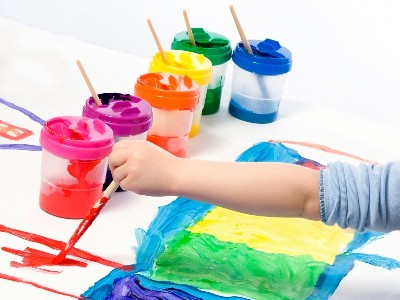
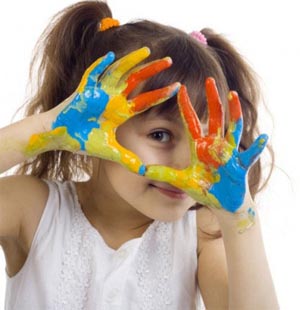
Exercises for the development of shallow motor
"Storm"
Drops first fell , (slightly knock on the two fingers of each hand on the table)
Spiders frightened (The inner side of the palm is lowered down; the fingers slightly bend and, turning it out, you should show how spiders are missing)
Rain stuck stronger (knock on the table with all the fingers of both hands)
Birds disappeared (arms crossed, palm join the back side; waving your fingers compressed together)
The rain watered like a bucket, (sticking hard on the table with all the fingers of both hands)
Running defores (Index and middle fingers of both hands run on the table, depicting men; the remaining fingers are pressed to the palm)
In the sky zipper sparkles , Thunder all the sky breaks (draw a finger in the air lightning) (drummed by fists, and then pat in your hands)
And then from clouds the sun (raise both hands up with open fingers)
Again looks in Uschka!
"Flowers"
Children perform movements with fingers in accordance with the text:
In our group on the window , (squeeze and squeeze cams)
In green in the country , (Show palms "pot")
In painted pots (raise palms up vertically)
Ground flowers. Here is a rose, geranium, fat man, cheek cacti family. (Finger bend on both hands, starting with a big one)
We are plenty of me , (watered from imaginary watering) (fold palms of both hands)
I and all my friends!
"Bell"
Children perform movements with fingers in accordance with the text:
- Don-Don Don,
- The bell rings (moving fingers with both hands)
- La la-la
- Something he says (to bring the index fingers of both hands to the mouth)
Ding Ding Ding
- Tilts the head (Lower the palms down)
Bom-bomb
- grumble all hairstyle (spend palms on the hair)
Dzin - Dzin - Dzin,
- He smiled at sun (smile and pat in your hands)
Finally woke up (knock on the fingers of one hand about the fingers of another)
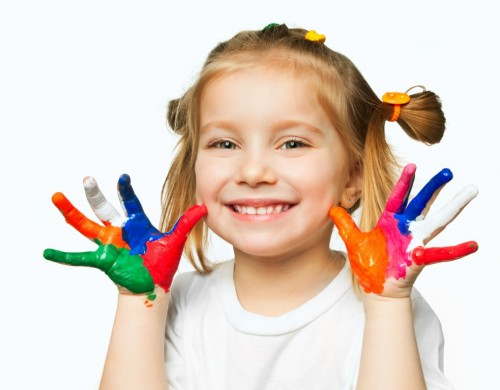
Psychodics for the development of the emotional sphere
Game "Shadow"
Two children walk along the road: one in front, another for two or three steps from behind. The second child is the "shadow" of the first. "Shadow" must immediately repeat all the actions of the first child, which will snew the flower on the side of the road, will get off for a beautiful pebble, then goes on one leg, etc.
"Forbidden Number" game
The game is aimed at the development of attention, memory and observation.
Children stand in a circle. Select the number that cannot be pronounced. Preschoolers believe in turn, instead of a forbidden number - clap your hands
Game "Here it is what"
The game is aimed at the development of attention, memory and observation.
A child without words with the help of expressive gestures "tells" about the size and forms of well-known items: small, large, pointed, round, quadranular, small, long, short.
Exercise "How do you feel?"
The exercise is aimed at developing care, empathy and ability to feel the mood of another.
Performed in a circle. Each child carefully looks at his neighbor on the left, trying to guess how he feels, and tells about it. Preschooler, the state of which is described, listens and then agrees or does not agree with the above, complements.
Exercise "My Mood"
The exercise is aimed at the development of empathy, the ability to describe their mood and recognize the mood of others.
The child suggests to tell the rest of his mood: it can be drawn, you can compare with any color or to show in motion - it all depends on the imagination and desire of the preschooler.
Exercise "Communication in a pair"
Exercise is aimed at the development of attention and memory.
Children are divided into pairs, sit back to back. One whisper tells about something, then asks another, what and what he said. Talking, the child must try to describe his feelings.
Exercise "Sitting - Standing"
The exercise is aimed at the development of the emotional sphere.
The child standing and looking at the sitting, says the phrase proposed or composed independently phrase with a different feeling: fun, with fear, angrily, calmly.
Exercise "Face Study"
The exercise is aimed at the development of tactile memory.
Children stand in two ranks, face to each other. Preschoolers of one rank close their eyes, in the other - change in places (arbitrarily) and fit closer to the first Sherge. Children with closed eyes feel the face and hair approached and call their names. Condition: It is impossible to touch clothes.
Exercise "Mirror"
The exercise is aimed at developing the ability to understand and transmit other people's emotions.
Children are divided into pairs, face each other and look at each other in the eyes. One begins to perform any movement, the other repeats it in the mirror image. The teacher then offers children in gestures and facial expressions to transfer different emotional states: sadness, joy, fear, pain, disgust, etc.
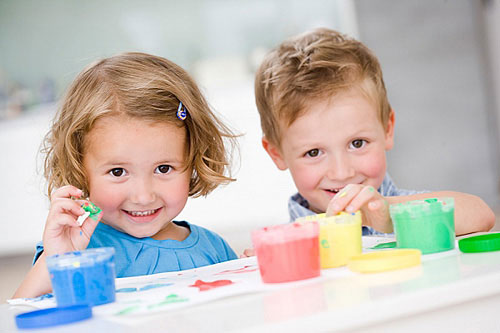
Exercise on the development of forming movements using stencil
Purpose: Develop the ability to perform circular movements when drawing a tangle in a closed circle with a support for visual control and with eyes closed. Strugging: Teacher offers children to consider the panel on which the kitten plays with balls of threads that he spacked. Then he offers children to collect threads in the tangle and shows how threads in the ball gather, imitating the movements of the pencil to wind the threads in the tangle. Periodically, the teacher offers children to close their eyes and perform movements with closed eyes. In order for children in order to have an interest in work, you can give them the opportunity to draw a lot of clubs, arrange a competition: who will draw more clubs.
Didactic exercise "Draw as plates on the table"
Purpose: Exercising children in painting round and oval forms, develop the ability to distinguish between the items large to small.To perform the exercise, children give stencils with slots of three circles of different magnitudes and three oval slots located between the circles. Ovals are also of different sizes, knobs are drawn to them.Travel course:The teacher says: "The children, three bear came to visit us. Let us treat them. For this we need dishes: plates and spoons. " The teacher shows the children stencils and offers to circle circles and ovals, and then draw to the ovals of the handle to get a spoon. After performing the Myster's task, along with children, they look at how all the work is performed, compared with a real serving on the table where plates and spoons are located. It can also be clarified from which side of the plate is a spoon.
Didactic exercise "Draw the Sun"
Purpose: Exercise children in drawing round shapes and straight lines. Claudion: "Enter the stencil and draw a circle." Children find a circle on the stencil and distribute it. After that, the first part of the stencil and the teacher suggests painting the rays of the sun with a finger. In another task, you can offer children to draw a dandelion with a stencil, buttons on a coat, a nevosha, balloons, etc. Before children begin to create plots of drawings, you need to teach them using a stencil to draw parts and objects that can then log in The plot: cloud, boat, rain, sun, waves, christmas trees, mushrooms, house, etc. It is necessary to start drawing with more simple items. For example: first paint the sun, later the cloud or mushrooms, and then the Christmas tree, snowman, nevosha, etc.
Didactic exercise in drawing directions of movement of objects in space
Material: stencils with the image of fish, ducks, geese, machines, aircraft, etc. Claims: Teacher offers children to consider images on stencils and shows how to handle the stencil to draw the subject, and then print it moving in another direction. After performing the drawing of items, children together with the teacher call the directions in which objects are moving in the figure: left or right, up or down, etc. Sometimes you can prevent drawing from the image cut from the image cuttings on the flannelheph or create subject situations from toys , real objects. Sometimes it is advisable to exercise children in the definition and image of the movement and direction with a support for the verbal instruction of the teacher: "Draw a car, rushing to the right, etc.".
Didactic exercise "decorate objects"
Purpose: Exercise children in the ability to fill in a limited space in accordance with the specified form of objects. Travel course: The teacher offers children stencils with slots of form of various items: dresses, caps, towels, nasal handkerchief, cups, kosninki, etc. Then the children paint the specified space. Depending on the level of development of the visual skills, the complexity of the contours of items is determined to each child individually: one paints the towel, the other is a dress. Such exercises enrich children's impressions of the form of real objects, learn to notice the common between them, in particular, that all items are painted with colored stripes, they are all different (dishes, clothes, underwear, etc.). So formed in children of skill to summarize objects one similarly, regardless of their functional purpose.
Didactic exercise in drawing leaves
And tree branches with leaves
Material: Stencils of leaves of various species of trees. Travel course. Children view stencils, examine the shape of the leaves. Then the teacher offers them to circle along the contour or stencil leaves. The task can be given to the speed: which of the children will encounter leaves more for a certain period of time. In another task, children after the stroke paint the leaves in different colors, so they get a pattern of colored leaves, in the following - create a pattern of leaves and branches. If children are able to draw objects on their own, you can task to create a sample plot on flannelhepho from contour images, and then sized. Mandatory drawing on stencils is only in the case of difficulties in children in the image of items.
Fish in aquarium
Purpose: Exercising children in the drawing of the subject, pushing out from the main form or form of additional details, to learn the audience analysis of the structure of the subject.
Move: The teacher offers children to consider stencils, where the main form of fish is given in the slots, and then draw the details, using already familiar non-traditional techniques.
Then children perform a stroke and dressing on the plan.
After creating an outline, the children are painted with paints, wovers, colored shallow, pastel.
Drawing starts with additional parts, drawing the main form Children can be performed using a stencil. And then using various types of non-traditional techniques.
In the same way, you can teach children to draw mushrooms, plane, flower, etc.

